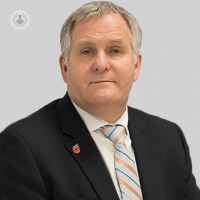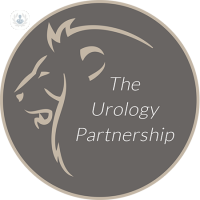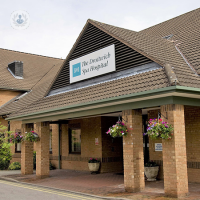What is a prostate biopsy?
A prostate biopsy is a test which is done in order to take small samples of tissue from the prostate, which are then looked at in more detail and analysed.

What does it involve?
There are generally two types of prostate biopsy.
The first is called TRUS (transrectal ultrasound) guided biopsy. First, an ultrasound probe is inserted into the rectum to allow imaging of the prostate. After this, a biopsy needle is inserted, and the samples are taken. On average, around 10 samples are taken using this method.
The second type of prostate biopsy is called a transperineal (template) biopsy. In this method, more samples are taken from different areas of the prostate. Around 30 - 50 samples may be taken using template biopsy. An ultrasound probe is inserted into the rectum, and imaging is used to correctly guide the needle. In template biopsy, the needle is inserted into the prostate through the skin between the testicles and perineum.
Why is it done?
Prostate biopsies are done in order to check for the presence of prostate cancer. Template biopsy is typically performed in those who have health concerns which do not permit a TRUS biopsy, or if a TRUS biopsy has been taken but the doctor suspects that prostate cancer is still present.
Preparation for a prostate biopsy
There is no specific preparation needed, but as a template biopsy is performed under general anaesthetic, making arrangements for someone to take you home after the procedure is advised.
What does it feel like during the test?
If you are having a TRUS biopsy, local anaesthetic is used, meaning the area is numbed. The procedure may feel a little uncomfortable despite this, as you lie on your side with your knees raised towards your chest. A gel is used while inserting the probe in order to make the process easier. The procedure only takes around 10 - 15 minutes. You may feel some discomfort in your rectum after the procedure and in the days directly afterwards.
In a template biopsy, general anaesthetic is used, meaning you will not be conscious for the test itself. The test takes around 20 - 40 minutes, and you will have to stay at the clinic for a few hours afterwards to recover from the anaesthetic.
What do the results mean?
After the biopsy, the samples will be sent off to be studied. Each sample will be analysed to see if they contain cancer, and how much cancer is present in each one. If cancer is found, your doctor will be able to tell you how aggressive the cancer is, and if it is likely to spread. They will also be able to tell you the type of cancer, if it is present.
If cancer is found, your doctor will explain to you what the results mean, and what the next steps are for treatment.
If cancer is not found, but your doctor suspects that prostate cancer is present, they may order further tests or another biopsy.
Advances in prostate biopsies
Developments in medicine mean that biopsies become more targeted, and the need for frequent biopsies is greatly reduced. Prostate MRI can be used in order to detect prostate cancer, and if a biopsy is necessary, a more accurate type of biopsy can be offered. This biopsy is called a transperineal MRI-ultrasound fusion biopsy. In this test, the needle is inserted through the perineum rather than the rectum.
07-23-2014 10-16-2023Prostate biopsy
What is a prostate biopsy?
A prostate biopsy is a test which is done in order to take small samples of tissue from the prostate, which are then looked at in more detail and analysed.

What does it involve?
There are generally two types of prostate biopsy.
The first is called TRUS (transrectal ultrasound) guided biopsy. First, an ultrasound probe is inserted into the rectum to allow imaging of the prostate. After this, a biopsy needle is inserted, and the samples are taken. On average, around 10 samples are taken using this method.
The second type of prostate biopsy is called a transperineal (template) biopsy. In this method, more samples are taken from different areas of the prostate. Around 30 - 50 samples may be taken using template biopsy. An ultrasound probe is inserted into the rectum, and imaging is used to correctly guide the needle. In template biopsy, the needle is inserted into the prostate through the skin between the testicles and perineum.
Why is it done?
Prostate biopsies are done in order to check for the presence of prostate cancer. Template biopsy is typically performed in those who have health concerns which do not permit a TRUS biopsy, or if a TRUS biopsy has been taken but the doctor suspects that prostate cancer is still present.
Preparation for a prostate biopsy
There is no specific preparation needed, but as a template biopsy is performed under general anaesthetic, making arrangements for someone to take you home after the procedure is advised.
What does it feel like during the test?
If you are having a TRUS biopsy, local anaesthetic is used, meaning the area is numbed. The procedure may feel a little uncomfortable despite this, as you lie on your side with your knees raised towards your chest. A gel is used while inserting the probe in order to make the process easier. The procedure only takes around 10 - 15 minutes. You may feel some discomfort in your rectum after the procedure and in the days directly afterwards.
In a template biopsy, general anaesthetic is used, meaning you will not be conscious for the test itself. The test takes around 20 - 40 minutes, and you will have to stay at the clinic for a few hours afterwards to recover from the anaesthetic.
What do the results mean?
After the biopsy, the samples will be sent off to be studied. Each sample will be analysed to see if they contain cancer, and how much cancer is present in each one. If cancer is found, your doctor will be able to tell you how aggressive the cancer is, and if it is likely to spread. They will also be able to tell you the type of cancer, if it is present.
If cancer is found, your doctor will explain to you what the results mean, and what the next steps are for treatment.
If cancer is not found, but your doctor suspects that prostate cancer is present, they may order further tests or another biopsy.
Advances in prostate biopsies
Developments in medicine mean that biopsies become more targeted, and the need for frequent biopsies is greatly reduced. Prostate MRI can be used in order to detect prostate cancer, and if a biopsy is necessary, a more accurate type of biopsy can be offered. This biopsy is called a transperineal MRI-ultrasound fusion biopsy. In this test, the needle is inserted through the perineum rather than the rectum.
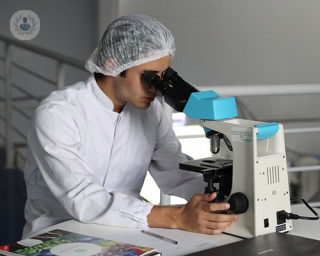

Diagnosing prostate cancer - having a transperineal prostate biopsy
By Professor Francis Chinegwundoh MBE
2025-01-28
1 in 8 men in the UK will receive a diagnosis of prostate cancer in their lifetime. The prostate is a male gland located between the bladder and penis, surrounding the urethra. The prostate grows in size with age and its main purpose is to help make semen, which is the fluid that carries the sperm. Professor Francis Chinegwundoh MBE, a renowned urologist, explains how prostate cancer can be diagnosed with a transperineal prostate biopsy. See more


What to expect from a prostate biopsy: Expert insight
By Mr Ashwin Sridhar
2025-01-28
A prostate biopsy is a crucial diagnostic procedure for assessing potential prostate cancer, a concern for many men as they age. But what exactly does this procedure entail? In essence, it involves the extraction of a small tissue sample from the prostate gland, located near the bladder and urethra. In his latest online article, Mr Ashwin Sridhar explores what happens before, during, and after a prostate biopsy, shedding light on its accuracy, safety, and potential discomforts. See more


What to expect from a prostate biopsy
By Mr Simon Brewster
2025-01-28
A prostate biopsy is used to remove tissue samples from the prostate gland so that they can be examined for ruling in or out prostate cancer. We've asked one of our top urologists Mr Simon Brewster what happens before the biopsy and what occurs on the day. See more
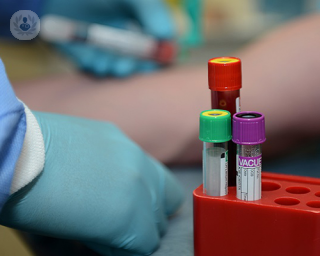

Diagnosing prostate cancer: tests and surveillance
By Mr Simon Bott
2025-01-28
Prostate cancer is the most commonly diagnosed cancer in men - in fact it is thought most men will develop it if they live long enough. How can doctors diagnose prostate cancer? Expert urologist Mr Simon Bott is here with the answers. See more
Experts in Prostate biopsy
-
Mr Christopher Anderson
UrologyExpert in:
- Kidney cancer
- Prostate cancer
- Laparoscopy
- Robotic surgery in urology
- Prostatectomy (prostate removal)
- Prostate biopsy
-
Professor Hashim Uddin Ahmed
UrologyExpert in:
- Cryosurgery
- Prostate
- Rezūm
- Green light laser surgery
- Prostate cancer
- Prostate biopsy
-
Mr Rick Popert
UrologyExpert in:
- Robotic surgery in urology
- Holmium laser (HoLEP)
- Prostate cancer
- Prostate biopsy
- Brachytherapy
- Benign prostate enlargement
-
Mr Richard Hindley
UrologyExpert in:
- Prostate cancer
- Benign prostate enlargement
- PSA test
- Green light laser surgery
- Prostate biopsy
- Bladder problems
-
Mr Mark Lynch
UrologyExpert in:
- Prostate cancer
- Prostate biopsy
- Benign prostate enlargement
- Bladder cancer
- Bladder problems
- Kidney stones
- See all

Thornbury Hospital - part of Circle Health Group
Thornbury Hospital - part of Circle Health Group
312 Fulwood Road, Sheffield S10 3BR
No existe teléfono en el centro.
By using the telephone number provided by TOP DOCTORS, you automatically agree to let us use your phone number for statistical and commercial purposes. For further information, read our Privacy Policy
Top Doctors

The Urology Partnership
The Urology Partnership
11 Kendrick Road Reading, RG1 5DU
No existe teléfono en el centro.
By using the telephone number provided by TOP DOCTORS, you automatically agree to let us use your phone number for statistical and commercial purposes. For further information, read our Privacy Policy
Top Doctors

The Droitwich Spa Hospital - part of Circle Health Group
The Droitwich Spa Hospital - part of Circle Health Group
St Andrews Rd, Droitwich WR9 8DN
No existe teléfono en el centro.
By using the telephone number provided by TOP DOCTORS, you automatically agree to let us use your phone number for statistical and commercial purposes. For further information, read our Privacy Policy
Top Doctors
-
Thornbury Hospital - part of Circle Health Group
312 Fulwood Road, Sheffield S10 3BR, SheffieldExpert in:
- Cardiology
- Colorectal surgery
- Endocrinology, Nutrition and Thyroid
- endoscopy
- Fertility
- Otolaryngology
-
The Urology Partnership
11 Kendrick Road Reading, RG1 5DU, ReadingExpert in:
- Aquablation
- Kidney stones (Urolithiasis)
- Prostate Cancer
- Kidney Cancer
- Urinary Incontinence
- Urology
-
The Droitwich Spa Hospital - part of Circle Health Group
St Andrews Rd, Droitwich WR9 8DN, Droitwich SpaExpert in:
- Abdominal ultrasound
- Abdominoplasty
- Vascular Surgery
- Arthritis
- Blepharoplasty
- Hip
- See all
- Most viewed diseases, medical tests, and treatments
- Fertility preservation
- Female infertility
- Undescended testicle (Cryptorchidism)
- Testicular ultrasound
- Minimal access surgery (keyhole surgery)
- NanoKnife
- Vaginal dryness
- Pelvic pain syndrome
- Kidney stones
- Medicolegal



